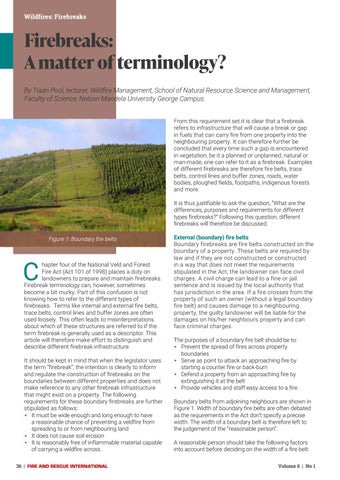Wildfires: Firebreaks
Firebreaks: A matter of terminology? By Tiaan Pool, lecturer, Wildfire Management, School of Natural Resource Science and Management, Faculty of Science, Nelson Mandela University George Campus From this requirement set it is clear that a firebreak refers to infrastructure that will cause a break or gap in fuels that can carry fire from one property into the neighbouring property. It can therefore further be concluded that every time such a gap is encountered in vegetation, be it a planned or unplanned, natural or man-made, one can refer to it as a firebreak. Examples of different firebreaks are therefore fire belts, trace belts, control lines and buffer zones, roads, water bodies, ploughed fields, footpaths, indigenous forests and more. It is thus justifiable to ask the question, “What are the differences, purposes and requirements for different types firebreaks?” Following this question, different firebreaks will therefore be discussed. Figure 1: Boundary fire belts
C
hapter four of the National Veld and Forest Fire Act (Act 101 of 1998) places a duty on landowners to prepare and maintain firebreaks. Firebreak terminology can, however, sometimes become a bit murky. Part of this confusion is not knowing how to refer to the different types of firebreaks. Terms like internal and external fire belts, trace belts, control lines and buffer zones are often used loosely. This often leads to misinterpretations about which of these structures are referred to if the term firebreak is generally used as a descriptor. This article will therefore make effort to distinguish and describe different firebreak infrastructure. It should be kept in mind that when the legislator uses the term “firebreak”, the intention is clearly to inform and regulate the construction of firebreaks on the boundaries between different properties and does not make reference to any other firebreak infrastructure that might exist on a property. The following requirements for these boundary firebreaks are further stipulated as follows: • It must be wide enough and long enough to have a reasonable chance of preventing a veldfire from spreading to or from neighbouring land • It does not cause soil erosion • It is reasonably free of inflammable material capable of carrying a veldfire across.
36 | FIRE AND RESCUE INTERNATIONAL
External (boundary) fire belts Boundary firebreaks are fire belts constructed on the boundary of a property. These belts are required by law and if they are not constructed or constructed in a way that does not meet the requirements stipulated in the Act, the landowner can face civil charges. A civil charge can lead to a fine or jail sentence and is issued by the local authority that has jurisdiction in the area. If a fire crosses from the property of such an owner (without a legal boundary fire belt) and causes damage to a neighbouring property, the guilty landowner will be liable for the damages on his/her neighbours property and can face criminal charges. The purposes of a boundary fire belt should be to: • Prevent the spread of fires across property boundaries • Serve as point to attack an approaching fire by starting a counter fire or back-burn • Defend a property from an approaching fire by extinguishing it at the belt • Provide vehicles and staff easy access to a fire. Boundary belts from adjoining neighbours are shown in Figure 1. Width of boundary fire belts are often debated as the requirements in the Act don’t specify a precise width. The width of a boundary belt is therefore left to the judgement of the “reasonable person”. A reasonable person should take the following factors into account before deciding on the width of a fire belt: Volume 6 | No 1



















